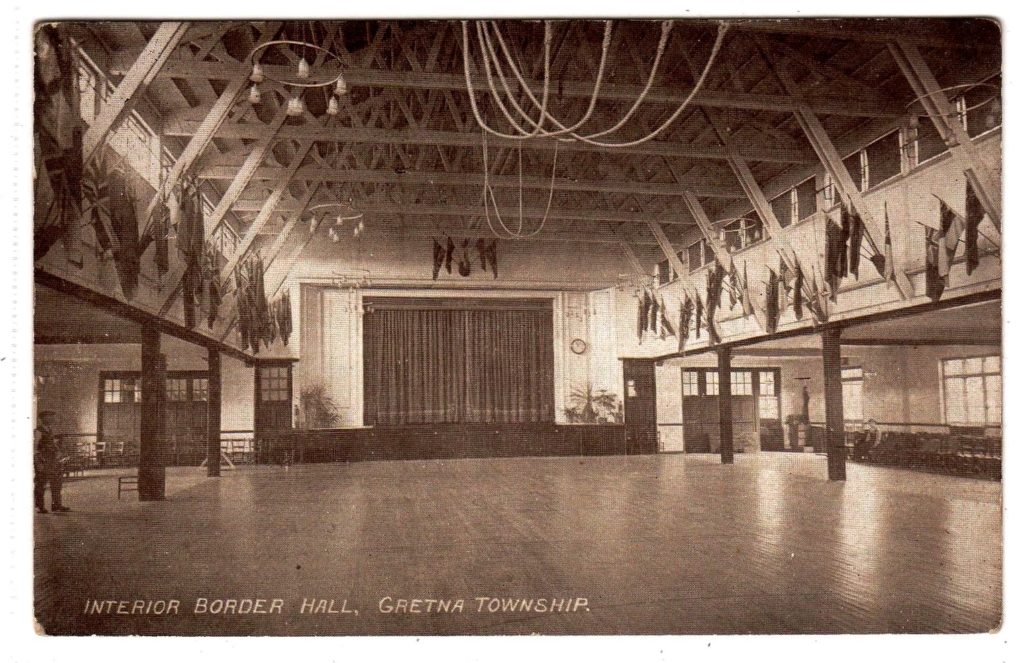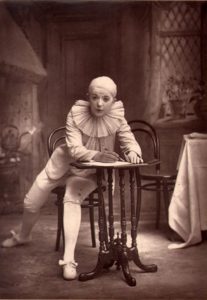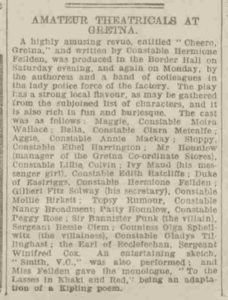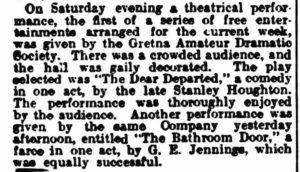Cheerio Gretna: Theatre at the Factory by Stuart Gibbs

In this blog post, Stuart Gibbs, one of the project’s volunteers, shares his research into the burgeoning theatre scene in Gretna.
As commemorations for the Great War continue, great emphasis has been placed on the home front and in particular the experiences of the munitions workers. Of the many centres for arms production during this period the giant plant at Gretna on the Solway has proved a great attraction for the commentator and historian becoming a short hand for the mass weapons production effort of that era. In 2015 the Centre Stage Community Theatre produced a play called the Timbertown Girls. Written by Chris Jones and inspired by Chris Brader’s 2014 social history of the same name, Timbertown Girls reflected the lives of the workers at HM Gretna.
My own involvement in that year’s Great War commemoration revolved around the Game for Girls exhibition in association with the Annan Museum. As Timbertown Girls highlighted among other things the women footballers of the munitions era, cast members from the play appeared for the exhibition opening complete in period costume. One of the aspects of factory life which the show highlighted was the exploits of the Gretna Works intrepid football team, the Mossband Swifts, however one omission made by Centre Stage’s production and Chris Brader’s history was that the munitions girls and their associates also treaded the boards.
Performance and Pierrots in Scotland before HM Gretna
The first theatrical productions in the south west of Scotland during the Great War took place before the plant’s construction. These were fund raising dances and concerts organised by the MacGeorge’s Glove Factory based in Sanquhar, the VAD, and the Motor Transport Army Service Corp, using venues such as the Sanquhar Public Hall. Other events held at the Victoria Hall in Annan and Cummertrees Hall were organised by Mrs Mabel Brook of Kinmount House and involved sketches and music. Another common feature of the live entertainment was the Pierrot troupe. Pierrot first made his appearance in the sixteenth century as a rather asinine figure before a romantic era reinvention as a stock everyman character trying to find his way in a bourgeois world. The character would cause a storm at London’s Prince of Wales Theatre in the early spring of 1891 with Pierrot appearing as the prodigal son in L’Enfant Prodigue. The Prince of Wales attended the shows on several occasions and also in the audience was the singer and banjoist Clifford Essex.
Essex saw the potential to use the character in a performance act and using the distinctive costume the Pierrots would become a group of travelling mistrals. Essex launched his new act, quite literally, at the 1891 Henley Regatta and when they performed to the delight of the Prince of Wales at Cowes they became the Royal Pierott Troupe.

The Pierrots’ weren’t gender specific. Mdlle Jane May was the lead in L’ Enfant Prodigue and women were often included in the line-up. Indeed, Francine Dewhurst appeared in Clifford Essex’s original Pierrot line up. Dumfriesshire’s premier troupe were known as the Sanquhar Ladies and were organised by a Bessie MacMillan, a member of the events committee at the McGeorge’s factory. The Sanquhar Ladies played several fund-raising concerts during the autumn of 1917. These included performances at Mennock School and Wanlockhead which featured music and sketches. From the money raised, food parcels were sent from Sanquhar to local territorials stationed in Egypt. In the two months prior to December 1917 they had raised £110 for war funds. The Pierrots were a popular addition to performances and most factories would have their own troupe: the sad clown struggling to make there way in an uncertain world would be all singing all dancing during war time.
Social Life at HM Gretna
In the aftermath of the ‘shell crisis’, industrial sites across the country were being converted to war work and new centres were being added to the mix. The largest by far was constructed on a site which stretched from Eastriggs and Gretna in the West to Longtown in the east, crossing from Scotland to England. Construction began in July 1915 with HM Gretna officially opening in June 1916 on four sites, and with Eastriggs and Gretna having purpose-built townships to house workers which would be christened ‘timbertown’. Like many production centres, HM Gretna developed a social and recreational programme, headed up by Ernest Taylor, a Chelmsford man, as the social manager. The plants general manager, David Gilmore, saw welfare schemes as an essential driver of efficiency. The need was also felt to keep the workers away from the drinking dens of Carlisle. Sports played a big part in these social activities with Taylor, in his youth, having been a player for Rochford Hundred FC and later serving on the London FA Council. Other social activities like dances, concerts and cinema, were also organised. Much of this activity has been well documented but the provenance of live theatre has been largely overlooked.
The centre of activity was the Border Hall, a multi-functional space set within the Gretna new town. In a press report on the Royal visit of George V to the township it was stated that the hall could accommodate over 1000 people, with sections of the hall able to be screened off to create smaller rooms and performance areas. Construction of the Hall began in November 1916 and was opened on 1 December 1916 with a grand bazaar. Lady Maud Warrington, head of the Rochampton Hospital, performed at the opening ceremony and one of the events organised by J. Darlison of the Dumfries Lyceum included 60 young munitionettes dressed in various period costumes performing in a historical pageant.
Gretna Amateur Dramatic Society
On 29 December 1916 the newly formed Gretna Amateur Dramatic Society staged The Bathroom Door by Gertrude Jennings. A prolific writer, Jennings also toured the allied positions in France where she performed and wrote for the service personnel. However, there is no evidence that she ever visited Gretna. The following evening a performance of The Dear Departed by Stanley Houghton was also well received. Houghton was part of the Manchester School of dramatists and besides acting, he also contributed critical pieces for the local Manchester press, the City News and Guardian. He would die a year before the war ended from illness following a trip to Venice.
Performance at the Border Hall
The Social and Athletic Club organised concerts at the Border Hall and at the nearby Carlyle Hall in Eastriggs but the first theatre production in the hall would be produced by the Gretna Amateur Dramatic Society on February 17th 1917. Shortly afterwards a Choral and Operatic Society was instituted for the factory and one of the society’s main instigators was a Stirling man, A. M. Lupton. Lupton was an engineer by trade and well known in Stirling’s amateur performance circuit, performing in concerts at the annual Royal Infirmary and a war fund benefit in Callander during May 1916. The society’s first production, HMS Pinafore, was held at the Border Hall on April 1917. Besides acting as stage manager, Lupton also played the part of Sir Joseph Porter, First Lord of the Admiralty. Another of the show’s stars was the baritone James McGregor. He would come to prominence in the society’s follow up performance Les Cloches de Cornville on 10 December 1917. Lupton would take his concert party on tour, of a sort, in the early months of 1918, where they played at the YMCA hall at Browhouses between Gretna and Eastriggs. Later concerts back at the Border Hall would also be well received but the staging in 1918 of Thomas Dibdin’s Paul Jones the Solway Mariner surpassed, according to the Dumfries Standard, all previous productions.
Women Police Performers at HM Gretna
During the 1900s various groups such as the Women’s Social and Political Union and the Women’s Freedom League had called, along with voting rights for women, for the appointment of women police officers. By 1916, women still hadn’t gained the vote but they did have a police force and 167 officers of the newly formed Women’s Police Service patrolled the Gretna factory site. In their down-time many of the officers engaged with hockey or athletics but during the early months of 1917 a theatre group was formed and worked towards their own revue, Cherrio Gretna, which was staged at the Border Hall on 5 May 1917. Written by Constable Hermione Feilden, Cherrio Gretna featured Constable Moira Wallace as the main comedian and Bessie Clem as Olga Sphellwitz, the German spy. Interestingly, Brenda Girvin’s Munition Mary would feature a spy within the factory but it would not be published until the late autumn of 1917.

During Cheerio Gretna, Hermione Feilden gave the monologue ‘To the Lassies in Khaki and Red’ after Kipling. Also performed was the sketch Smith VC, written by Rica Bromley-Taylor. The sketch centred around two munitions girls vying for the attention of an award winner in the middle of his recruitment tour. Bromley-Taylor was part of the Jewish community and would no doubt have been drawn to the story of the real Smith VC, Issy Smith: born in Alexandra, Egypt, of Russian Jewish descent Smith was cited for his actions during the second Battle of Ypres. On his return Smith spoke at recruitment meetings across the country including Bradford, Dublin and Manchester. Falling on hard times in the post war period, Smith was forced to pawn his medals. The Jewish Historical Society of London recovered the awards however and he was reunited with them in 1925. The WPS performers reprised Smith VC as part of Motor Transport Corps variety show at the Gretna Institute. A few weeks later, a burlesque sketch Gretna Justice written by one of the corps, Lance-Corporal Ashen, was also performed.
The more formal Amateur Dramatic Society would continue presenting sketches as part of events to what Mrs Mabel Brook and Bessie McMillan had staged at the start of the war. An early attempt at dramatising the munition girls experience was Charlotte Annie Kimberley’s Brave Women Who Wait – A Munition Girl’s Love Story (written under the name Mrs F. G. Kimberley): toured under J. C. Carlyle’s company this play appeared at Carlisle’s Her Majesty’s Theatre in early 1917. The Gretna dramatic society never quite produced such large scale productions and during late November they would once more perform the short pieces: Stanley Houghton’s Fancy Free and the Gertrude Jennings’ sketch A Rest Cure. Jennings’ domestic comedy of errors portrayed the varying attitude of two carers towards a languid invalid and would doubtless have struck a cord with the contemporary audience. Indeed the subject matter of both authors shows the desire by youth for personal freedom and the clashing of the social classes would seem the appropriate choice for the Gretna audience.
Social Cohesion through Performance
A high proportion of prodigal daughters who flooded into Gretna were under 18, a far larger number than any other centre with young girls. Many travelled from as far afield as Dunblane, Sunderland, the Isle of Man and South Wales. Often girls from the same area would travel to the Gretna plant where they would share the same accommodation and even work the same shifts. This would lead in some cases to conflict amongst these different groupings. Welsh girls who insisted on speaking their own language tended to be resented and there was also friction between the Scots and English workers. It may well have been felt that the material presented on stage would help with social cohesion and in time relations did become more relaxed between the different groups. At a performance held at the Border Hall on 10 May 1918, three sketches were performed – Married in Haste by the Kansas born writer Clyde Westover, Ida Collaborators by Esme Wynne and Noel Coward, and what appears to be a local composition A Collection Will be Taken, perhaps a take on the common practice of taking collection taking at theatrical events.
The drama society’s largest performance was Sir Arthur Pinero’s play The Schoolmistress performed in the weeks of 21 October 1918. This farce in three acts was first performed at the Court Theatre, London in the early spring of 1886. The story sees the headmistress of a girls’ school thinking that she had married into higher status, but subsequently struggling to support her layabout husband, while her pupils plot behind the scenes. This play may well have appealed to the young people at Gretna. There were very few married couples at Gretna, but there were 550 children on the site catered for by schools in Eastriggs and Gretna and many of these youngsters also took to the stage. During the summer of 1918 the youngsters staged their own variety performance in aid of the Red Cross.

The end of Gretna
By this time the war was winding down, as were staffing levels, with as many as two thousand workers let go by May 1918. One of the Operatic Society’s stars, James McGregor, was given a benefit on 29 June on his taking up a new post in the South. After the declaration of the armistice, demobilisation went into full swing but there was to be one last show at the Border Hall. On 20 December 1918, the curtain came down on Gretna’s wartime theatre with the Dramatic Society’s farewell performance, The Gondoliers. The Gretna Institute would host hustings for the General election of December 1918 with further meetings held in Eastriggs specially aimed at the newly enfranchised women voters. However many of the workers whose wartime effort had helped sway public opinion in favour of enfranchisement were too young and too poor to take part. At the time Gretna and centres like it were seen as a strange social experiment. We can see it, however, as one of the early waves of change which led to our modern society. The theatre performed at Gretna reflected, to an extent, the mood of this change. At the end of the war much of the two Townships would be retained after an auction of HM Gretna’s infrastructure during the summer of 1925. There were no bids however for the Border Hall and the grand structure was demolished during April 1928.
